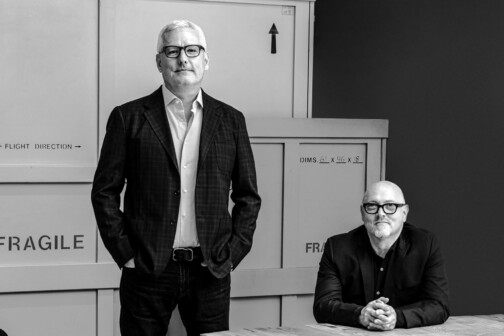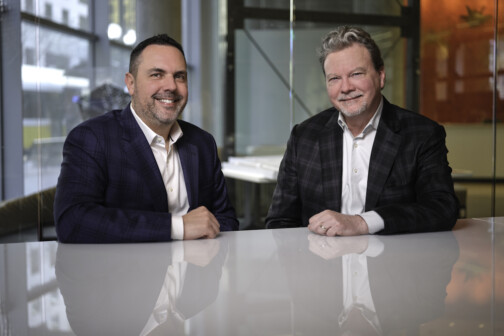Grabbing a round of drinks on The Mining Company’s outdoor deck. Perching on the upper mezzanine of Sue Ellen’s for New Year’s Eve. Crossing Throckmorton atop a rainbow-painted crosswalk. Over 50 years ago, Oak Lawn began to build a rich community of LGBTQ residents and businesses. Today, Cedar Springs Road remains a vibrant mix of gay-friendly retail, bars, nightclubs, and restaurants in the heart of Oak Lawn, where change will soon come.
Real estate developer and Dallas native Mike Ablon will have a hand in such change. He plans to build two high-rise towers in the gayborhood behind a stretch of mostly one- and two-story buildings that contain the beating heart of the community.
Specifically, as the Dallas Voice reported last week, “Caven [Enerprises], which owns TMC–The Mining Company, Sue Ellen’s, JR.’s Bar & Grill and Station 4, will sell its properties to PegasusAblon but continue to own and operate its bars. The sale involves property on the west side of Cedar Springs Road, from Reagan to Throckmorton Street, and at 4001 Cedar Springs Road.”
For those familiar, that’s behind Roy G’s and S4. Caven also owns the parking lots behind the buildings, which means the company is paying taxes on land that isn’t generating revenue. Something has to change. Bringing in Ablon was viewed as a way to develop the land without kicking out the businesses.
Ablon, a former mayoral candidate, has done this before. He reinvigorated the Design District without stripping the neighborhood of its character. He only leased to local businesses with a likeminded concern for aesthetics. Ablon is driven by questions like, “What complements with here?” and “Who is the local talent that does it in a way that’s of Oak Lawn, of Dallas, of the community?” He says this is his underlying approach.
The goal, Ablon says, is to look at what’s needed and work from there. One such need is more housing. Another is a gathering place, a communal hub for the area that’s currently lacking one. The heart of Oak Lawn, he says, is the corner of Throckmorton and Cedar Springs, “but you can’t stand in the middle of the street to wait for each other, so I’m going to build an urban room, a gathering spot, an urban collection point…wrapped around existing buildings, and to let you know it was there I put a 70-foot waterfall coming down.” It’s not subtle. Though two high-rises, somewhere in the realm of 20 stories tall with 450 rental units, among single story buildings can’t exactly be subtle.
So nestled between the towers is a central space, facing casual restaurants or whatever might occupy those ground floor units, where people can meet. Maybe on the second floor, says Ablon, there’s a place to have a nicer meal or a glass of wine, with tables overlooking the rally point down below. It won’t be all white-linen dining, but the plan is to have a mix of both higher and lower priced dining options (and/or shopping options). “The juxtaposition of items brings a flavor and a richness,” the developer says.

A key component to maintaining the area’s current richness—like Sue Ellen’s, believed to be the oldest lesbian bar in Texas and one of the few left in the country—is leaving existing buildings alone. Ablon says that is his intention. “I will keep everybody who’s there, there. I will not change any of them, not the people working the front door, not the barstool,” he says.
It’s an agreement Ablon struck with Caven Enterprises to ensure the neighborhood’s soul remains intact. Former Dallas City Councilman Ed Oakley represented Caven at an informal Q&A at The Mining Company this week, fielding questions from a crowd of a few dozen. Oakley, who’s been a big part of Oak Lawn’s growth, explained the situation to the masked attendees.
“We have three and a half acres, 150,000 square feet of land; the buildings take up about a third of that. And so we’re paying property taxes on parking spaces that are much needed but they don’t generate anything,” he said.
That doesn’t play well in a fast-growing city.
“In an urban setting, the sea of parking needs to be utilized for something else in a different manner… We have retail. We have restaurants. We certainly have the bar business. We need residential.”
The problem Oakley kept coming up against were developers who suggested leveling the blocks entirely and building new housing—six stories at least, or high-rises. “But nobody wanted to develop it with the bars existing, and that was not acceptable to us. We were in a quandary,” said Oakley.
Enter Ablon, who says definitively that he’s here to preserve the bars and the essence of Oak Lawn.
“I must keep what’s there, and I must keep the buildings, and I must keep the culture, and I must keep the people, and I must keep the venues.” It reads like a list of urban design commandments, half of which would get readily thrown out the window by many developers. For Ablon, though, preserving those elements that root you in a sense of place—a vibe, you can call it, or character—is part of his business model. “That’s very important to me because it’s important to the community. I won’t tear the buildings down, I’m going to build around them.”
This can be defined very narrowly. In Ablon’s previous neighborhood revitalization of the Design District, he barred the Meddlesome Moth from changing the tile and mosaic on the floor. (Not that the bar and restaurant wanted to, for the record, but Ablon was strict about retaining character.) He says he recognizes Oak Lawn’s importance for and to the LGBTQ community. “That is a safe place, that is the heart and soul of a community, and you don’t displace that—you celebrate it, you nurture it, you fortify it,” he says. “And then maybe you expand it in certain ways.”
As with any change, though, not everyone is convinced it’s for the betterment of Oak Lawn. Some folks at the Q&A pelted Oakley with questions. Why couldn’t it be something akin to condos instead, so they could become homeowners? Many brought up concerns surrounding traffic, which can be a headache along Cedar Springs, particularly on pre-pandemic weekend nights. Pedestrian mortality rates were brought up. What about the potential for noise complaints from new residents in those big towers, some queried? Others were there to say the bars were already way too loud. Parking—will we still have spaces? All good questions, though Oakley couldn’t deliver all of the answers. (On parking: Yes, there will be parking in the new buildings.)
People are worried, perhaps more broadly, about what will be taken away than what Ablon plans in terms of “bringing new additional flavors to broaden the offering.”
“I enjoy the idea of…helping the neighborhood fortify its own identity, its own richness, its own mythology, its own ethos because that’s what builds great cities.”
Mike Ablon
The particulars of what exactly will be those additional flavors are still unknown. Construction isn’t scheduled to begin until mid-2022 or so. But the philosophy—the community-driven philosophy, says Ablon—is what’s hopefully reconciling this part of Oak Lawn’s smaller buildings with sky-grazing new ones.
For them to coexist, Ablon needs to build enough units and square footage to make the numbers work without sacrificing the soul of a place. Like walking down a city sidewalk and where history and present day “actually highlight each other” rather than clash. While generating revenue. It’s a difficult balance. “When you’re looking at newer history and older history—generations or hundreds of years—the distinctions between them are profound,” says Ablon.
Oak Lawn, the “gayborhood,” a community proud of its LGBTQ denizens and visitors, has a history and a character. What Ablon is proposing—and we’ll see how it all shakes out once the construction dust has long settled—is sustaining that essence amid inevitable growth and change in the city. Buildings come down and new ones go up everywhere all the time. The question is how to do so thoughtfully.
When change comes to a community in the form of high-rises and shiny new modern builds, there will be those who respond with deep skepticism. Often it’s justified. Too many times have contemporary structures been shoe-horned among charming buildings patinated by history and weather. What should be clear for Oak Lawn: New buildings will go up eventually. Big ones, tall ones, residential ones. That is a clear fate for Oak Lawn. And what a lot of people, fairly, oppose about the development is the development itself. It will change their beloved neighborhood. What Oakley at Caven is trying to do with Ablon will almost certainly not please everyone, but they describe a better outcome than letting any developer build whatever they want without considering if the project makes Dallas a better place. If it’s not Ablon in 2022, then it’s likely someone else in five or 10 years from now. And they may not care about S4.
In the early ’80s, Oak Lawn was a neighborhood in transition. Gay-operated businesses were growing. Now the neighborhood is entering another transition, but one in which the spirit of its LGBTQ community must live on.
“Dallas is a young city that’s maturing and I enjoy the idea of going into a neighborhood and not commodifying the neighborhood but helping the neighborhood fortify its own identity, its own richness, its own mythology, its own ethos,” Ablon says. “That’s what builds great cities.”
Get the D Brief Newsletter
Author






